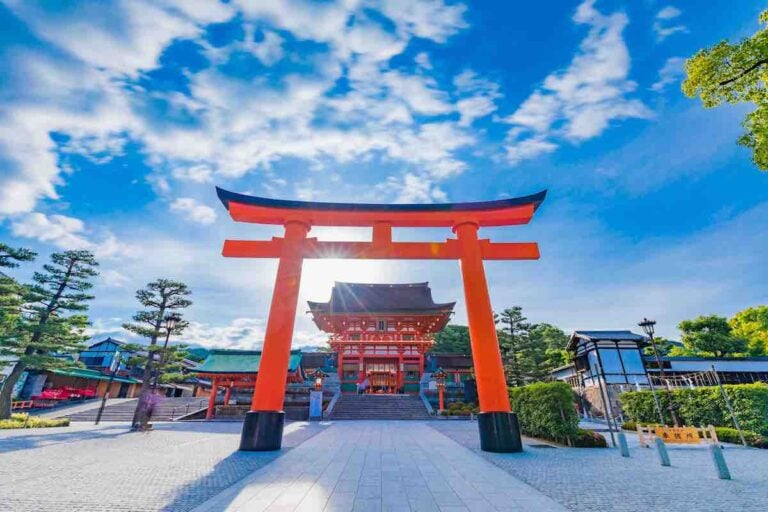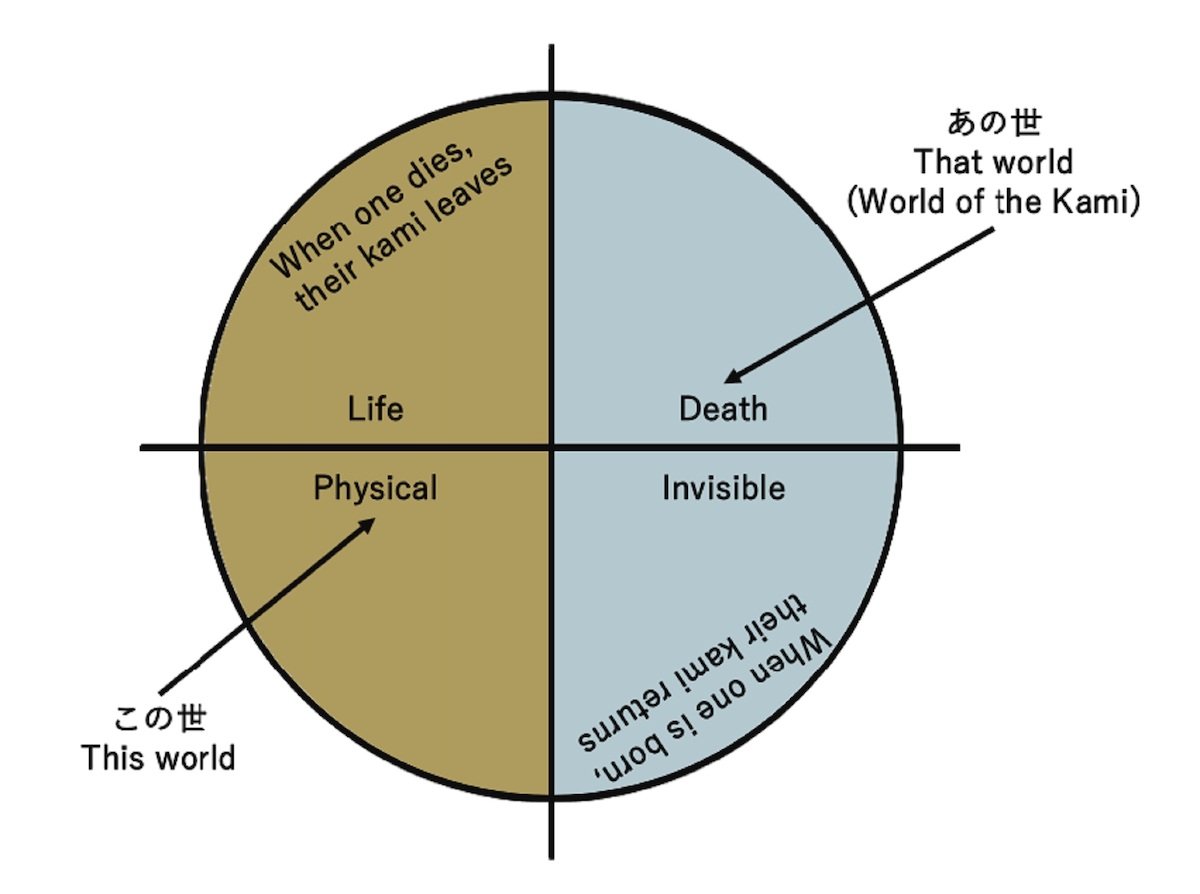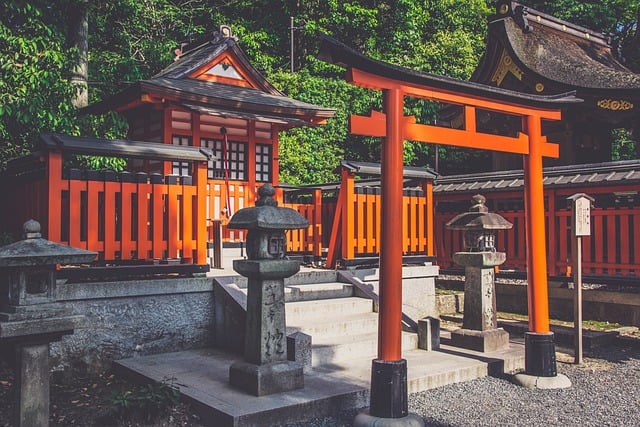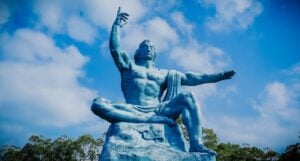
Everyone has seen the famous bright red gates that seem to pop up all over Japan, but do you know why they exist? These are a fundamental symbol of Shintoism known as Torii gates. Shintoism, the oldest and largest religion in Japan, underpins many elements of Japanese culture. Have you ever attended a Japanese festival full of chanting men carrying large boxes down the middle of the street? Or perhaps you seen the many bright red shrines and the iconic Japanese Torii gate, but didn’t understand what all the clapping and bowing was about. Or perhaps you are an anime fan and have fallen in love with famous movies such as Spirited Away and Princess Mononoke, but don’t quite understand what all those spirits and their underlying themes were about.
Shintoism is regarded as Japan’s indigenous religion. In this article, I would like to explain what Shintoism is, where it came from, and its role in both historical and modern day Japan.
What is Shintoism?

To break down Shintoism, it is good to understand the breakdown of religion in Japan. The Japanese word for religion is shukyo (宗教) which breaks down to the character 宗 or sect and 教 or teaching. In words like Bukkyou (仏教/Buddhism) or Kurisutokyo (クリスト教/Christianity), you will notice the kanji 教. This is because the word kyo/教 is used for religions with teachings (such as the word of Christ or the teachings of the Buddha).
However, the word Shinto (神道) consists of shin (神) which is the character for kami or soul/spirit/god and to (道) which is the character for path or “way of”. A direct translation would be “The Way of the Spirit” or “The Way of the Kami”. This makes the word more alike to words like sado (茶道 or “Way of Tea”) or budo (武道 or “Way of Martial Arts”). This is because Shinto is not a direct teaching of doctrines and literature. Instead, it is a set of thoughts and attitude inherited from ancient animism over time.
What does this mean? Shintoism isn’t a religion? Well that’s not quite true, but in a sense Shintoism isn’t a taught religion like Buddhism. Instead, it is a collection of mindsets and views that root in historical legends and mythology. For much of Japanese history, including modern day, Shintoism rooted in cultural norms. However, in the 8th century, the imperial family compiled the stories of ancestors as a means to justify the imperial reign. During Japanese modernization, the view of the imperial family became political and religious. This is what led to a concept known as State Shintoism.
This means there are two versions of Shintoism: Shrine Shintoism and State Shintoism.
Where does Shintoism come from?
Experts claim that the history of Japan started around 10000 BCE. In this time, the islands separated from the Chinese continent due to falling sea levels at the end of the last glacier period. At the start of the Neolithic period (known as the Jomon Period or 徐門時代), there was immigration from the continent through the southern and northern routes. These people carried many cultural practices with them.

In traditional western theology, there are three common stages of religious development. First is the primitive stage (animism and shamanism). Animism is the the belief in a supernatural power that organizes and animates the material universe. Shamanism is the belief in a person regarded as having access to and influence in the world of spirits. The second stage is the polytheistic stage. This stage consists of stories of gods which explain natural phenomena and their relationship to the human world. Essentially, it is seen as the personification of nature as gods. For example, polythesim is seen in Greek, Rome, Norse, and Hindu mythology. The third stage is the monotheistic. This is when there are teachings about how to lead our lives based on creation of the universe (heaven and earth. This stage tends to be unique to the western world as seen in Abrahamic religions like Christianity and Islam.
Typically, when we use the term religion, we often attribute three elements to the concept:
- founder (such as The Buddha or Jesus Christ)
- Holy Book (such as Sutras or the Bible)
- Symbolized Buildings (such as Temples or Churches).
Shintoism does have the final criteron (in shrines or 神社), but lacks the former two. In a sense, Shintoism is a primitive religion (at least according to this idea of theological religious development). Shintoism doesn’t have a founder or a singular Holy Book. Instead, Shintoism is a collection of mythologies and practices rooted in a long cultural history.
In ancient Shinto belief, Izanagi and Izanami were the seventh male and female gods. As traditional myth goes, these two gods thrusted a halberd from the bridge of heaven into the sea. Upon withdrawing their halberd, they formed the islands of Japan. Izanami then gave birth to various gods until dying at the birth of fire. Upon her death, Izanagi purified himself leading to the birth of three more deities: Ameterasu-o-Mikami or the sun goddess, Tsukuyomi-no-Mikoto or the moon god, and Susanoo-no-Mikoto or the tyrant of the seas. Amaterasu sent her grandson Ninigi-no-Mikoto down from heaven to rule over god. The Imperial line is believed to descend from him. This will come up more later when discussing State Shintoism, but for now just note that Shintoism contains many mythologies such as this.
Shrine Shintoism – 社信仰
Shrine Shintoism is the belief in the way of the kamis or the place where kamis reside. Kami is a bit of a complicated concept that often gets translated to “gods” in English. However, this translation is a bit inaccurate. A better way to think of kami is a mysterious power that gives life. Essentially, in simplified terms, when the kami enters the body, there is a birth, and when it leaves, there is a death. Death leads to the world of the kamis and over time the kami will then return and be reborn into a new life. This creates a cycle of life and death that is as regular as the four seasons (Spring is birth → Summer is growth → Autumn is maturation → Winter is death).

Because of this circular pattern of life and death, Shintoism consists of a circular way of thinking that is common in my Eastern religions. Time becomes a flow of repeating patterns rather than a linear sequence that is more common in Abrahamic religions. The world becomes divided into this world (この世) and that world (あの世). This world is living and physical, but when one dies their kami leaves and returns to that world (the world of kami). When one is reborn, their kami returns to this world and the cycle continues. The sun, mountains, wind, rain, rocks, trees, and all other natural phenomena were also believed to be the dwellings of kami. This makes both the natural world and the human world intrinsically connected.
Kami can be seen as all of one’s deceased relatives. If worshipped, kami are benevolent to humans, but when humans abused nature, nature grows angry and calamity occurs. This is what leads to Japanese shrines (神社) as the gateway between this world and that world. Traditionally shrines sit at the foothills of a mountain where the kami resided. The shrine consists of two parts: haiden (拝殿) which is a building where worshippers pray and honden (本殿) which is a building that contains the symbols of the enshrined kami.

To keep harmonious relations with mother nature, the people had to treat nature with respect. By visiting the temporary residence of the kami (the shrine), people were able to offer their respect to the kami. This maintains balance between the human world and the natural world.
Later the belief of the Jomon period blended with an agrarian belief that developed in the Yayoi Period (from 5th and 3rd century BCE to 3rd century CE). This led to agrarian economics with the distribution of products and the regulation of society. The social stratification began to oppose the Jomon’s traditional society. However, as society shifted, the belief in kami became an unconscious foundation. The Yayoi, Kofun (300 to 538 CE), and Asuka periods (538 to 710 CE) were known as the periods of unification. Japan consisted of many small communities that combined into one country. Influential families immigrated from the Korean peninsula and new political systems began to spread. When the country was unified, it was originally named Yamato. It was later renamed to Nippon/Nihon (日本 or origin of the sun) after the belief the emperor was the descendent of the sun god.
Each country had their own respective stories about their ancestry, over time the stories. Over time they combined into the justification of imperial reign in the early 8th century
Integration of Buddhism

According to the ‘Nihon Shoki’, Buddhism came to Japan in 552 CE during the Asuka period (飛鳥時代). Holy King of Baekje presented statues and teachings of Buddha. Prince Shotoku (聖徳太子,574-622CE) played a major role in spreading this faith among commoners.
Organized religions, like Buddhism, offers detailed explanations about life and death. Because of this organized nature, Buddhism also came scientific technologies such as architecture. This scientific advancement was popular to the then influential Soga Clan. Other influential families saw this as an affront to the traditional ‘kami’ or gods leading to conflicts until the Hakuho period (白鳳時代, 673-686 CE). In this time, the official patronage of Buddhism changed to the imperial family. This means Buddhist institutions became an important part of the centralizing reforms of this era (known as the Taika reforms 大化の改新).
In the Nara Period (奈良時代, 710–794 CE), the political thought of Shintoism justified the imperial family’s reign. Ancestorial spirits were believed to guard the imperial family from their family shrine. However, alongside with Shintoism, Buddhism was a source of the latest scientific advancements. The national religion became Buddhist as rulers of this time believed this would keep the nation peaceful. This being the concept of chingokokka 鎮護国家 or the spiritual protection of the state.
The image of the Great Buddha (大仏) was raised in 749 CE as the representation of the sun as the mercy of Buddha. This imagery blended well with the sun of the goddess Amaterasu. It was in this time that the syncretic fusion of Buddhism and Shintoism began to rise. This is a phenomenon in Japan known as shinbutsu shugo (神仏習合) which means “the integration of the kami and the buddha”. This was integration roots back to the Heian Era (平安時代, 794 – 1185). The merging of Shinto deities with Buddhist practice still exists all throughout Japan.
State Shintoism
Buddhism and Shintoism merged as practitioners followed both religions. In 1853 western powers began to enter Japan after decades of isolation. Samurai families divided into supporters of the Tokugawa (an influential clan in Japanese history) and supporters of the imperial family. However, the Meji government were finally able to defeat the Tokugawa and gain power. This is when the mythical part of the “Nihon-shoki” reformed into Neo-Shintoism (国家神道). Shintoism played a role in both political thought (帝国主義) and religion (天皇信仰) and Japan transition into imperialism.

Much popularity around Buddhism fell with the eradication of the Daimyos and Shogunate. This resulted in the systematic separation of Shintoism and Buddhism in the Kami and Buddhas Separation Order (神仏判然令) of 1868. Ordinary citizens were pressured to believe Japan as a divine country (神国) protected by the descendant of Amaterasu (the Emperor). Shintoism became the state religion with new ideologies to return to a pure “Japanese spirit”. Buddhism became viewed as a corruption of foreign influences that tainted this Japan.
To further the view of Buddhism as a corrupting force, Buddhism became associated with the Shogunate. This rooted in the Tokugawa danka system (檀家制度) that combined Buddhist temples with historical ruling powers. Fueled by growing resentment, religious persecution of Buddhist practitioners spread across Japan. A growing trend known as haibutsu kishaku (廃仏毀釈, literally: “abolish Buddhism and destroy Shākyamuni”). This led to the dismantling of Buddhist institutions, the confiscation of land, the destruction of Buddhist books and artifacts, and in some instances, the death of monks.
State Shintoism which supported the power of the emperor, allowed Japan to militarize under imperial power. Supporting war effort was seen as a way to push Japan into modernization and become a major power. However, after World War II, state Shintoism was abolished through the Japanese consitution. The separation of religion and state was established allowing for the remergance of Buddhist influence in Japan. Of course, the political history in this time is more complicated, but for the purposes of this article, you simply need to know that the influence of state shintoism declined post World War II.
Shintoism in Modern Day
While popularity for Shintoism waned in modern day, Shintoism is still seen all throughout everyday life. From weddings to traditional festivals to popular media, Shintoism can be seen everywhere. Due to Shinto’s focus on ritual behavior rather than doctrine, it is easy to overlook the many places Shintoism exists. In fact, in modern day, it is nearly impossible to differentiate between Shintoists and Buddhists in Japan. If you ask many Japanese people, they will likely simply say “I have no religion”. However, both Shintoism and Buddhism have faded into unconscious cultural norms rather than overt religious belief.
both Shintoism and Buddhism have faded into unconscious cultural norms rather than overt religious belief.
One obvious place you will notice Shintoism is at the Shinto Shrines (jinja/神社) or literally “kami-place”. There are over 100,000 Shrines across Japan and can be found anywhere from isolated rural countryside to dense urban settings. Typically shrines consist of a complex of buildings in architectural styles that date back to the Heian period. As mentioned before, the inner sanctuary, or the honden (本殿), is where the kami resides. Here Shintoists keep things that belong to the kami, such as artwork, musical instruments, and so on. Near the honden there are also subsidiary shrines, or bekku (別宮), that house other kami. Additionally a haiden (拝殿) is present at a shrine to provide halls of worship. The lower level of the haiden is where the hall of offering known as heiden (拝殿) is located. Together the honden, haiden, and heiden are known as hongu (本宮).
At the entrance of the shrine is a large (often times painted red) gate known as the torii (鳥居). The torii is the demarcation between our world and the world where the kami resides. Passing beneath one is an act of purification. Often it is expected to bow before passing through the torii gate to show respect to the kami inside. Additionally because the path is the gateway between the world of kami and our world, the center of the path where the kami travel. Because of this, many people remain on the edges of the paths at a shrine and avoid walking in the center.
A major aspect of Shinto rituals is the process of purification, or harae (祓 or 祓い). Upon entering a shrine, it is important to use water (misogi/禊) to wash your face and hands in a process known as temizu (手水). Another form of purification occurs at the start of a Shinto ritual which includes waving a white paper streamer known as haraigushi (払い串). As mentioned before, all natural phenomena are traditionally thought to be the dwellings of kami. Because of this, it is important in Shintoism to treat nature with respect. This fundamental importance of respecting and caring for nature is the foundation of purification rituals.

Alongside regular visits to shrines, there are also a variety of festivals associated with Shintoism. Because Shintoism is a community-based religion, festivals are a central act of worship. Most mark the seasons of the agricultural year and involve the progression of the kami with a variety of offerings. During these processions, the kami travel in portable shrines known as mikoshi (神輿).
In modern day, buying talismans for anything from driving safety to traveling to good health and so on is still popular. Likewise, weddings are still often held in the Shinto style. However, things like death, which is seen as a source of impurity, remain in Buddhist temples. So while you visit Japan, feel free to partake in many of the Shinto cultural rituals by visiting shrines and attending matsuris. But remember while you do to always show the kami (and by extension the natural world) respect.
If your interested in learning more about Buddhist influences on Japanese culture, feel free to read the history of Buddhism here: https://jobsinjapan.com/living-in-japan-guide/the-history-of-buddhism-in-japan/
For further reading on Shintoism:
- Azegami, N. (2012). Translated by Mark Teeuwen. “Local Shrines and the Creation of ‘State Shinto'”. Religion.
- Inoue, Nobutaka (2003). “Introduction: What is Shinto?”. In Nobutaka Inoue (ed.). Shinto: A Short History. Translated by Mark Teeuwan and John Breen. London and New York: Routledge.
- Kitagawa, J. (1987). On Understanding Japanese Religion. Princeton University Press.
- Teeuwen, M. & Rambelli, F. (2002). Buddhas and Kami in Japan: Honji Suijaku as a Combinatory Paradigm. London: Routledge Curzon.
- Shimada, H. (2022). Nihonjin no Shintō: Kami saishi jinja no nazo O toku. Chikuma shobō. [日本人の神道:神・祭祀・神社の謎を解く]


















